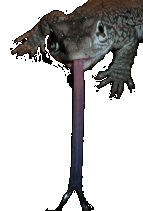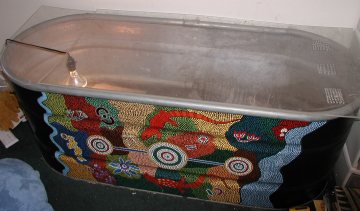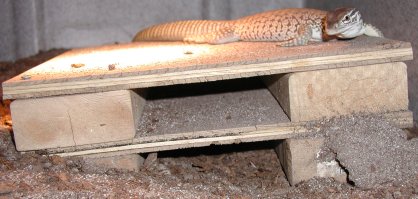


Housing
3.0 What important factors must I consider to house my monitor?
3.1 How large does the enclosure need to be?
3.2 What type of enclosure can I use for monitors?
3.3 What type of enclosure can I use for larger monitors?
3.4 Do monitors only grow to the size of their enclosures?
3.5 Can monitors escape from enclosures easily?
3.6 What furnishings need to go into an enclosure?
3.7 What type of substrate should be used?
3.8 What temperature should their environment be?
3.9 How do I regulate air temperature?
3.10 What lighting does a monitor need?
3.12 What's the best way to keep the enclosure clean?
3.0 What important factors must I consider to house my monitor?
Before purchasing a monitor one must have an adequate enclosure set up for it. The enclosure is a very important part of proper monitor husbandry. The best enclosures will be insulated to hold both heat and humidity. A good substrate is needed for burrowing. The enclosure must be large enough for adequate hide areas; a water bowl, basking area and you must be able to provide the proper thermal gradient. For many species the best type of enclosure is a trough or stock tank, which are available at many feed stores. They come in a multiple of sizes with the largest I have seen being 8'x3'which can suit the needs of an averaged sized monitor.
3.1 How large does the enclosure need to be?
The best answer to this is as big as humanly possible. Remember in this case bigger is better. That said there are minimums that a monitor should be kept in. The best rule of thumb to follow is the enclosure should be twice as long as the monitor and as wide as the monitor is long. For instance a four foot monitor should be kept in a cage that is AT LEAST 8' long by 4' wide. Again this is the minimum and if you can go larger than by all means do so. You want enough space so that your monitor can move around comfortably and have access to all temperatures in the thermal gradient you provide. Due to the rapid growth of monitors it is best to plan ahead with enclosure size. The most economical and practical cage would be one large enough to house an adult no matter what size the animal is now.
3.2 What type of enclosure can I use for monitors?
There are many styles of enclosures sutable for monitors. If you must use a smaller tank for a hatchling than required for an adult there are several options available. The most obvious are the glass cages manufactured for reptiles. You can also use glass aquariums for fish although you will have to design a secure lid for these. With either one of these the screen top should be eliminated. Screening not only causes excessive heat loss but it will also dehydrate the cage and thus the monitor very rapidly. This can cause many health problems one of the most obvious is retained shedding. You can replace the screening with plexi-glass relatively cheaply. You can also custom order a cage or build one, but if you go this route you might as well build one or order one that is large enough to house an adult.
 For dwarf
monitors to mid-sized monitors (no bigger than 4' in total length) the best
type of cage I have used are troughs or stock tanks. These can be purchased
from feed or agriculture stores. They can be bought in a variety of sizes
the minimum size for even the smallest monitor would be one that is 4' long
by 2' wide. For these you will have to fabricate your own lid. The best lid
for these is a sheet (or two) of (painted trough in room)
For dwarf
monitors to mid-sized monitors (no bigger than 4' in total length) the best
type of cage I have used are troughs or stock tanks. These can be purchased
from feed or agriculture stores. They can be bought in a variety of sizes
the minimum size for even the smallest monitor would be one that is 4' long
by 2' wide. For these you will have to fabricate your own lid. The best lid
for these is a sheet (or two) of (painted trough in room)
plexi-glass. For ventilation you can drill a series of holes near one end. The holes should be drilled above the cool end of the enclosure. You want to have enough ventilation to provide for an exchange of air but not too much such that air can freely escape the enclosure.
One thing to avoid is a cage made from screen. These types of cages will hold your monitor only long enough for him to completely shred it up and thus escape. Also cages with large screened lids should also be avoided. These types of cages can create problems with regulating temperatures and dehydration.
When purchasing a cage you should also keep in mind whether you want a front opening cage, often with sliding glass doors, or a cage which opens from the top. The main advantage of a front opening cage is they can often be stacked thus saving room. With keeping monitors this advantage is far outweighed by the disadvantages associated with these cages. Front opening cages make it difficult to provide a deep substrate because they often only have a liter dam that is only a few inches high at best. If the cage is deep enough (over 2' in depth) then you can put a few inches of substrate toward the front and then create a hill of substrate toward the back which is deep enough to allow your monitor to burrow. This however limits your monitor's choices of where to burrow to where you have made the hill. Another problem with front opening cages with sliding glass doors is the substrate will often get in the siding door track. This makes it difficult and sometimes impossible to open the door. This can be remedied by having a door that swings up or down on a hinge, however the substrate problem will still be present.
3.3 What type of enclosure can I use for larger monitors?
Depending on the species, you have a few choices. For the larger monitors you are very limited to what you can build or you can dedicate an entire room to the monitor. A relatively cheap enclosure can be built out of plywood and 2x4s. A non-toxic waterproofing coat should be added to the wood to prevent it from warping. Marine resin (used to repair fiberglass boats) is an inexpensive and effective way to water proof the wood. One must follow the directions carefully and be sure to mix the hardener and resin accurately. You should also provide plenty of time for the resin to dry and do not place an animal in the enclosure until you can no longer smell any fumes from the resin. Another popular material for building enclosures is melamine. This is basically particle board with a thin plastic like coating. Personally I do not like this material for monitor enclosures. For one it is very heavy and hard to work with. Second the plastic coating does little to waterproof the enclosure and eventually the particle board will begin to deteriorate. I have heard of other problems associated with use of this material as well.
3.4 Do monitors only grow to the size of their enclosures?
No, this is a myth. Monitors will continue to grow regardless of cage size and in too small of a cage this can cause serious health problems. The monitor will not be able to thermo-regulate and can easily overheat. There have been cases where monitors spines have become crooked from growing in a cage that was too small. Besides being cruel, a monitor will more than likely die if kept in a cage which is too small. The cage should be large enough to allow for plenty of choices in movement and hiding areas.
3.5 Can monitors escape from enclosures easily?
Monitors are excellent escape artists. Their intelligence combined with their power makes it possible to exploit any weak link in your enclosure. They will work away at a small hole until it is large enough for them to escape out of. They also will remember how they escaped, and if the enclosure is not improved, they will escape again.
3.6 What furnishings need to go into an enclosure?
This depends on the type of monitor. However there are
three basic needs of all monitors. They will need a basking area (this will be
covered more below), hide areas, and a water bowl. Some monitors, such as water
monitors (V. salvator) may benefit from a large pond in which they can swim
around. Such ponds require extensive filtration and or daily water changes, as
the monitor will often defecate in the water. Smaller water bowls should always
have a fresh supply of water. For hatchling monitors be sure not to fill the
water too deep as there is a potential for them to drown. Adequate hide areas
are important as well. There should be multiple options of hide areas across the thermal gradient so as not to force your monitor to hide
in too cool or too warm of a spot. Monitors will often utilize their burrows as
a hiding area but other options should also be available. Hiding areas will cut
down on the amount of stress placed on a monitor in captivity.
Other types of furnishing to provide are hollow logs,
large branches to climb, and perhaps rocks. You can also decorate the enclosure
with silk plants or even live plants. However (Ackie enclosure
with water bowl, rock, basking platform, log,
hallow log/cork cark, and clay
statues)
the monitor will often destroy small live plants very rapidly and silk foliage will often be rearranged by the monitor. Hollow logs can be useful both as a hiding area and for some species a nesting site.
3.7 What type of substrate should be used?
The best substrate for many monitors is plain dirt. You can dig up your own dirt; this makes it both free and unlimited. Just about any type of dirt can be used and will be suitable for burrowing. However dirt which is heavy in clay should be avoided if possible. Again this is simply for burrowing and an adequate nesting substrate may be something entirely different.
Another good substrate, particularly for Indonesian monitors is cypress mulch and leaf litter. This substrate will hold moisture well and will allow for burrowing. It is also very easy to clean. The only problem with cypress mulch is its availability. It is impossible to find in some areas however Pro Exotics offers large bags of it for sale and they will ship it.
3.8 What temperature should their environment be?
The most accurate word describing temperature for monitors is choice. You do not want to force your monitor to use certain temps but rather you want to create a thermal gradient with a range of usable temps for your monitor. The range of temps I have been most successful at are from a 130-150 degree basking spot down to about 70-75 degrees on the cool end. Remember the basking spot is just that a spot. It should be about the size of the monitor's body. A too small of an area and the monitor will not be able to use the heat properly. A too large of an area and the proper range of temps will not be provided and your monitor may not be able to escape the heat.
 The easiest
and most effective way of making a basking area for many of the smaller species
of monitors is with a multilevel plywood stack. Basically its 2x4's separating
plywood sheets. This allows for different temps on different levels. Place
the stack (Sand monitor using basking platform)
The easiest
and most effective way of making a basking area for many of the smaller species
of monitors is with a multilevel plywood stack. Basically its 2x4's separating
plywood sheets. This allows for different temps on different levels. Place
the stack (Sand monitor using basking platform)
right below your heat source and you are done.
The best heat source I have used for creating a high basking spot and a steep thermal gradient is halogen floodlights. I have used many types of reptile heat lamps, ceramic heat emitters, heat panels and none are as effective as halogen lighting. You can purchase these bulbs at any hardware store. You should purchase a bulb that is between 45 watts and 75 watts depending on your needs. Most people assume that a higher wattage bulb will produce more heat and thus they go for high wattage bulbs. However rather than buying higher wattage bulbs all one has to do is move the bulb closer or farther away from the basking spot to achieve the ideal temps. Higher wattage bulbs heat the air more and thus more air is escaping the enclosure. This warm air is humid (hopefully) and is replaced by dry cool air. This leads to the dehydration of the cage and eventually the monitor. This is why lower wattage bulbs tend to be better for heating an enclosure.
For larger monitors a bank (two bulbs next to each other) of bulbs may be necessary. This will produce a larger basking spot under which the entire body of the monitor will fit. Again these should be low wattage bulbs.
3.9 How do I regulate air temperature?
The easiest way to regulate the temps is through a combination of ventilation and your basking light. In my 5' x2'x2' trough a have a single 50-watt halogen light bulb. The bulb is roughly 6" from the basking spot. The temps range from 150 degrees under the basking spot to 76 degrees on the cool side of the trough. This is my only heat source.
Basking bulbs work very well in smaller cages and well-insulated cages. However if you have a very large enclosure and are in a cool climate, then you may need additional heating. For heating the air I recommend radiant heat panels. They are very effective and last for many years. Heat pads can also be used to provide a warm place for your monitor to lay.
3.10 What lighting does a monitor need?
Some people believe it is important to have a day/night cycle for monitors. These people believe improper light cycles cause monitors to stress and become unhealthy. If done properly however this simply is not true. I look at it as 24 hour heat not 24 hour lighting, and this maximizes the choices available to the monitor. It is not only important to have adequate hide areas available for this to work but it is also important to have a proper substrate in which your monitor can burrow. Monitors are on their own schedule and can care less about your schedule and their lighting schedule. They will retire to their homes (burrows) around the same time regardless of the light. If you ever look into a burrow of your monitor it is very, very dark. I tend to be able to only see in inch or two into the burrow. To them, it is night.
If you decide to have a day/night cycle then you must provide some sort of supplemental heat at night. This can be through a ceramic heat emitter, a radiant heat panel, or perhaps a reptile night bulb. As for how long the day cycle should be and how long the night cycle should be, it really does not matter. Your monitor will go to sleep when it wants not when you tell it. Besides, for it to be natural you would have to have the same exact day/night cycle from the exact local your monitor was collected. This information is more than likely next to impossible to obtain. Furthermore, you would then have to adjust the day/night cycle every couple of days. Even after you did all this, your monitor still will not care.
There is no available information regarding the benefits or drawbacks of providing UV lighting for monitors. Most lights available that produce UVA or UVB produce miniscule amounts of these rays. I have raised monitors with both UVA and UVB and some without UVA and UVB lighting and have not been able to determine any differences. If you want to provide this type of lighting go ahead but it is not necessary.
3.12 What's the best way to keep the enclosure clean?
You should spot clean your monitors enclosure every time you see feces. This only takes a few seconds a day and is not difficult. Every so often I use a shop-vac and suck up the top layer of dirt in my monitor's enclosures. If you do not use dirt or do not have a very deep substrate then you may have to change out the entire substrate as it becomes soiled. You should always have fresh clean water available to your monitors and this usually means changing the water very often. Monitors seem to get incredible joy of washing themselves off in their water bowl, especially after you have recently changed it.